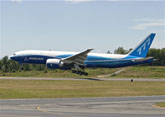The first Boeing 777 freighter took to the sky for the first time from Paine Field in Everett and completed an initial series of tests during a flight lasting more than three-and-a-half hours.
"The 777 freighter completed the scheduled three-hour inaugural flight with no airplane performance-related issues," said Dennis O'Donoghue, vice-president of flight operations, test and validation.
"The only issue was a data-communication problem between the airplane and the telemetry room at Boeing Field."
Because of the data-transmission issue, the 777 was unable to complete all of the first-flight tests and was returned to Paine Field according to Federal Aviation Administration procedure.
During the flight, 777 chief pilot Suzanna Darcy-Hennemann and 777 deputy chief pilot Van Chaney took the airplane to an altitude of 18,000 feet (5,486m) and an air speed of 270 knots (500km/h), customary on a first flight.
Typically, the 777s cruise altitude is 35,000ft, and its cruise speed is Mach 0.84, about 779km/h.
The 777 freighter, the sixth member of the 777 airplane family, will be capable of flying 9,047km with a full payload, making it the world's longest-range twin-engine freighter.
The airplane's range capability will translate into significant savings for cargo operators: fewer stops and associated landing feeds, less congestion at transfer hubs, lower cargo handling costs and shorter cargo delivery times.
To date, Boeing has secured 78 firm orders from 11 customers for the 777F. The planemaker aims to deliver to launch custiomer Air France by the end of the year.
CargonewsAsia













